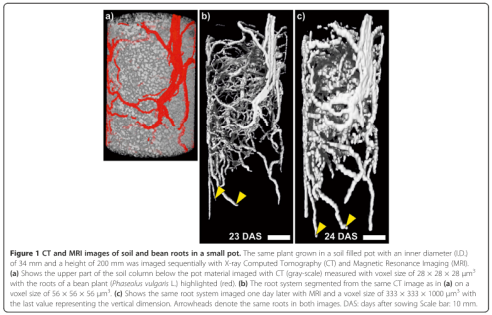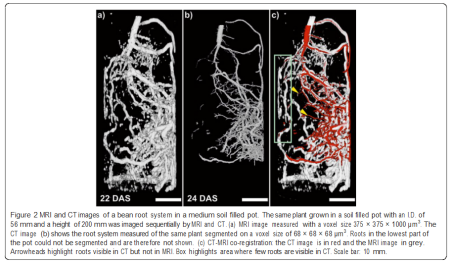品质至上,客户至上,您的满意就是我们的目标
技术文章
当前位置: 首页 > 技术文章
德国Fraunhofer利用植物断层扫描CT发表根系研究论文
发表时间:2020-05-08 09:35:37点击:2437
来源:北京博普特科技有限公司
分享:
较先进的应用研究院Fraunhofer研究院的EZRT研究所科研人员,发表了题为Direct comparison of MRI and X-ray CT technologies for 3D imaging of root systems in soil: Potential and challenges for root trait quanti�0�3cation的论文,研究使用计算机断层扫描系统对根系进行了断层扫描研究,并与MRI测量方法进行比较,文章发表在Plant Methods上,研究结论是2种技术在利用适合监测发芽的根发育的小直径花盆研究时,效果相同。要研究特定根结构或细根渐进直径,CT优势较有优势, 因其空间分辨率较高。对大型直径花盆而言,MRI 比CT可提供较多的根系区,很可能是由于MRI能取得较强的根系与土壤对比。CT配合MRI可以取得互补信息,2个模块组合提供了一系列额外可能性,例如在不同土壤结构或不同土壤湿度下分析根系统性状。

Fraunhofer植物计算机断层扫描系统采用微焦点X射线成像原理进行较高分辨率三维成像,可以在不破坏样品(无需染色、无需切片)的情况下,获得高精度三维图像,显示样品内部详尽的三维信息,并进行结构、密度的定量分析,适用于观察植物化石样品结构和植物活体组织的细胞结构,近年来被广泛应用于结构学、组织学、生物学特别是古生物学等研究领域,例如花、果实、种子、根系等研究。
Fraunhofer研究院是较先进的应用技术研究院,很多工业技术都源自于该研究所。Fraunhofer专门成立的植物表型CT研究组致力于CT技术应用在植物的表型研究上。与传统医学CT不同,植物CT研究需要少有算法和软件等,Fraunhofer研究院在该研究领域位于较前沿。
近年来,Fraunhofer团队一直致力于将计算机断层扫描技术应用于植物表型研究领域,特别是专注于植物结构高分辨率无损检测。其中一个研究方向为研究外在胁迫因素对植物微观结构的影响,研究方向有木质部结构如何对胁迫,如干旱做出反应。在干旱环境下,一些植物不再为叶片或整个枝条提供水分。研究另外一个方向是不同植物基因品系的内部微观结构特征。
Fraunhofer开发出了便携式、台式、落地式以及高通量等多个系列专门针对植物表型研究开发的计算机断层扫描系统。
便携式植物断层扫描仪
应用于对植物种子、小型果实内部结构变化的研究。可以无损地探索不同植物种子腔体、胚和胚乳的变化,测量种子内部的三维结构和小型果实的内部变化,设备小巧便携,操作简单,具有中分辨率和高分辨率两种选择。
实验室植物断层扫描成像系统
广泛应用于植物对植物根系、茎杆的内部结构变化的研究。可以无损地探索盆栽中不同植物的根系变化,也可以测量茎杆等植物器官的3D结构。
北京博普特科技有限公司是Fraunhofer系列产品中国区总代理,全面负责其系列产品在中国市场的推广、销售和售后服务。
Direct comparison of MRI and X-ray CT technologies for 3D imaging of root systems in soil: potential and challenges for root trait quantification
Ralf Metzner1*�6�9, Anja Eggert2�6�9, Dagmar van Dusschoten1, Daniel Pflugfelder1, Stefan Gerth2, Ulrich Schurr1, Norman Uhlmann2 and Siegfried Jahnke1

Abstract
Background: Roots are vital to plants for soil exploration and uptake of water and nutrients. Root performance is critical for growth and yield of plants, in particular when resources are limited. Since roots develop in strong interaction with the soil matrix, tools are required that can visualize and quantify root growth in opaque soil at best in 3D. Two modalities that are suited for such investigations are X-ray Computed Tomography (CT) and Magnetic Resonance Imaging (MRI). Due to the different physical principles they are based on, these modalities have their specific potentials and challenges for root phenotyping. We compared the two methods by imaging the same root systems grown in 3 different pot sizes with inner diameters of 34 mm, 56 mm or 81 mm.
Results: Both methods successfully visualized roots of two weeks old bean plants in all three pot sizes. Similar root images and almost the same root length were obtained for roots grown in the small pot, while more root details showed up in the CT images compared to MRI. For the medium sized pot, MRI showed more roots and higher root lengths whereas at some spots thin roots were only found by CT and the high water content apparently affected
CT more than MRI. For the large pot, MRI detected much more roots including some laterals than CT.
Conclusions: Both techniques performed equally well for pots with small diameters which are best suited to monitor root development of seedlings. To investigate specific root details or finely graduated root diameters of thin roots, CT was advantageous as it provided the higher spatial resolution. For larger pot diameters, MRI delivered higher fractions of the root systems than CT, most likely because of the strong root-to-soil contrast achievable by MRI. Since complementary information can be gathered with CT and MRI, a combination of the two modalities could open a whole range of additional possibilities like analysis of root system traits in different soil structures or under varying soil moisture.
Keywords: X-ray Computed Tomography (CT), Magnetic Resonance Imaging (MRI), Root system architecture, Common bean (Phaseolus vulgaris L.) 3D imaging, Roots in soil, Non-destructive